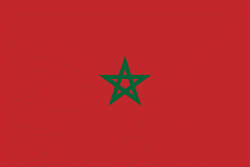Ahfir
Ahfir (احفير, ⴰⵃⴼⵉⵔ) is a town in Berkane Province, Oriental, Morocco, adjacent the border with Algeria. According to the 2004 census, it has a population of 19,482. The name Ahfir refers to the stone quarry which was exploited in this village founded by Hubert Lyautey at the time of the French protectorate. This village, which is inhabited by Beni Iznassen, was the gateway to the French invasion by Lyautey in 1907 leading to the imposition of the French protectorate from 1912 until 1956.
The name Ahfir means "Hole" in Berberized Arabic and would refer either to the great war trenches that were dug in this territory located near the Moroccan-Algerian border before the construction of the city by Hubert Lyautey, or to the stone quarry that was exploited in this village at the time of the French protectorate (Martimprey-du-Kiss). The city is located on the territory of the Beni Khaled tribe, part of the Iznassen tribe.
The name Ahfir means "Hole" in Berberized Arabic and would refer either to the great war trenches that were dug in this territory located near the Moroccan-Algerian border before the construction of the city by Hubert Lyautey, or to the stone quarry that was exploited in this village at the time of the French protectorate (Martimprey-du-Kiss). The city is located on the territory of the Beni Khaled tribe, part of the Iznassen tribe.
Map - Ahfir
Map
Country - Morocco
 |
 |
| Flag of Morocco | |
In a region inhabited since the Paleolithic era over 300,000 years ago, the first Moroccan state was established by Idris I in 788. It was subsequently ruled by a series of independent dynasties, reaching its zenith as a regional power in the 11th and 12th centuries, under the Almoravid and Almohad dynasties, when it controlled most of the Iberian Peninsula and the Maghreb. In the 15th and 16th centuries, Morocco faced external threats to its sovereignty, with Portugal seizing some territory and the Ottoman Empire encroaching from the east. The Marinid and Saadi dynasties otherwise resisted foreign domination, and Morocco was the only North African nation to escape Ottoman dominion. The 'Alawi dynasty, which rules the country to this day, seized power in 1631, and over the next two centuries expanded diplomatic and commercial relations with the Western world. Morocco's strategic location near the mouth of the Mediterranean drew renewed European interest; in 1912, France and Spain divided the country into respective protectorates, reserving an international zone in Tangier. Following intermittent riots and revolts against colonial rule, in 1956, Morocco regained its independence and reunified.
Currency / Language
| ISO | Currency | Symbol | Significant figures |
|---|---|---|---|
| MAD | Moroccan dirham | د م. | 2 |
| ISO | Language |
|---|---|
| AR | Arabic language |
| FR | French language |















